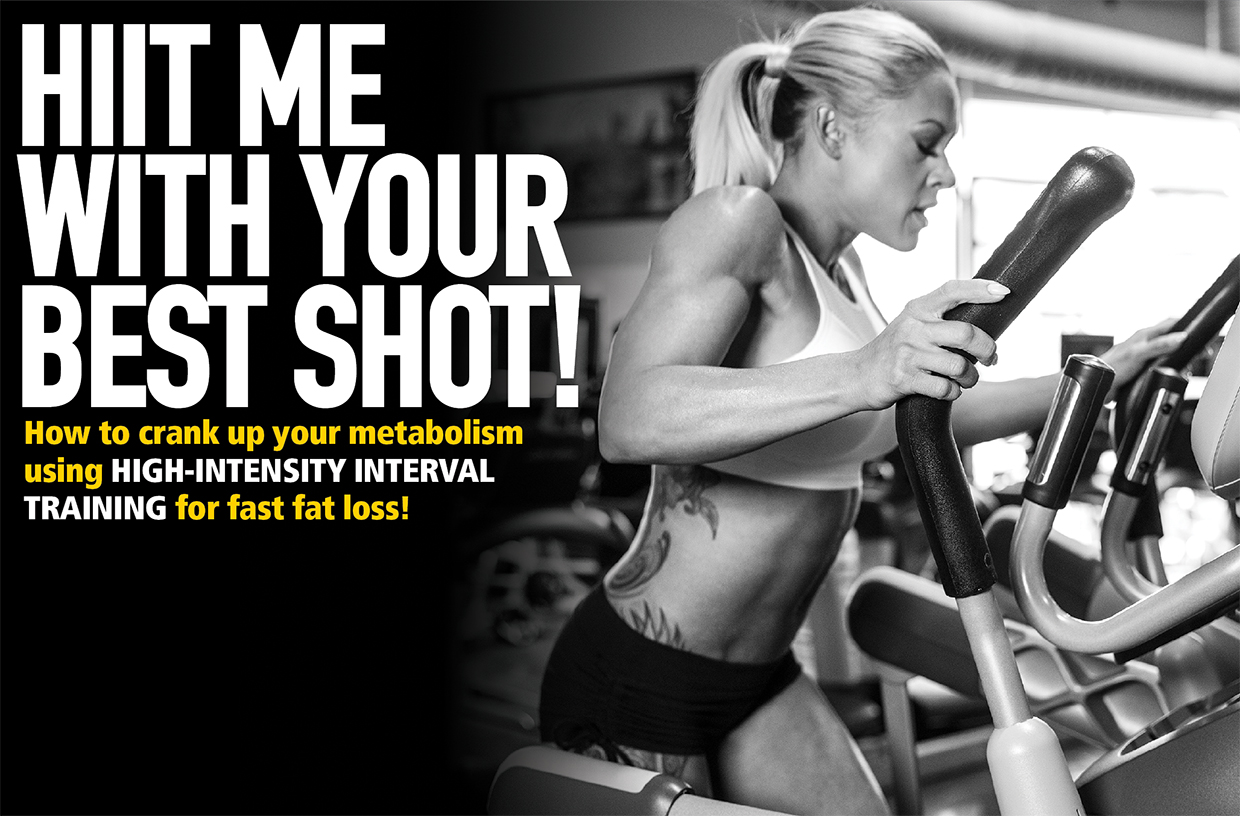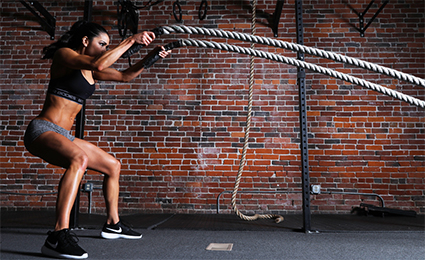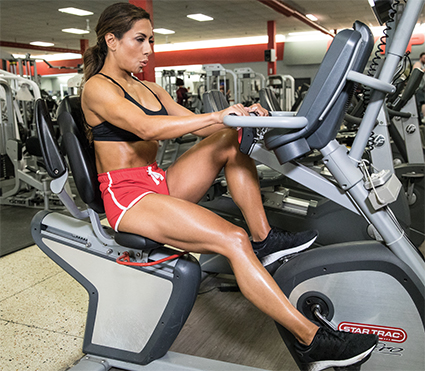HIIT Me With Your Best Shot

How to crank up your metabolism using High-Intensity Interval Training for fast fat loss!
What’s the first thing most people think of when they think of fat loss? Cardio. Yep, hour upon hour of boring, mind-numbing cardio. Why? Because that’s what’s been ingrained into our heads. You want to lose fat? Time for lots of cardio.
Here’s the problem: There’s a reason you have to do so much of it—traditional cardio, or rather, aerobic exercise, doesn’t burn many calories to begin with. The elliptical says you burned 1,000 calories in 10 minutes—sorry, not true. All of the machines overestimate calorie expenditure. Numerous shortcomings emerge when you focus your fat-loss efforts on session after session of steady-state cardio, but we’ll come back to that. First, we’re going to look at a far more effective, time-efficient, albeit more intense, approach to fat-loss cardio.

HIGH-INTENSITY INTERVAL TRAINING (HIIT)
Most people have at least heard of interval training, a form of cardio in which you repeatedly alternate periods of high- and lower-intensity effort. Interval training is normally defined by a work-to-rest ratio in which the work component represents the high-intensity, sprint portions and the rest component represents the low-intensity, active recovery portions.
Repeatedly alternating a 30-second sprint with a 90-second brisk walk would be an example of interval training with a 1:3 work-to-rest ratio, the rest lasting three times longer than the work. The specific details of how you set up an interval program aren’t that important. As long as you work hard, then rest, the specifics aren’t critical to your success. That said, a 30- to 90-second high-intensity segment and anywhere from a 1:1 to a 1:3 work-to-rest ratio— from 30 seconds on/60 seconds off up to 90 seconds on/90 seconds off—is probably going to be your best bet for fat loss more often than not. Of course, there are times when you can do shorter and longer intervals as well.
Okay, so we now know what interval training is, but the big question is, is it really superior to traditional steady-state cardio when it comes to fat loss? What about the fact that everyone in the gym seems to do steady-state cardio? Well, look around. How many people do you see slaving on the elliptical for an hour every time you’re in the gym—and yet they never look any different? Pretty common observation, isn’t it?

A BETTER WAY TO BURN FAT
Here’s the problem with overreliance on steady-state cardio for fat loss: Aside from the fact that it’s boring and time-consuming, one of the biggest problems is that the more you do, the more you have to do. As you become more aerobically fit, you’ll become a more efficient fat burner. Sounds good, doesn’t it? How much fuel does a fuel-efficient car burn? Not much. It gets a lot of output, or mileage, for little input, or fuel. Same with us. The more efficient we become, whether aerobically or biomechanically, the less energy our bodies have to expend for a given amount of activity. Efficiency sure sounds good, but when we’re trying to lose fat, we want to be inefficient fat burners. Look at a lot of physique competitors— they start off with 30 minutes of cardio three to four times a week, and by the time they’re done dieting, they’re up to 60 minutes twice a day and even more in some cases. Did the 30 minutes four times per week stop producing results, or did they become more efficient?

 THE FAT-BURNING ZONE
THE FAT-BURNING ZONE
What about the often-heralded fat-burning zone? I’m sorry to say that the fat-burning zone is completely overrated. As you sit there reading this article, you’re in the fat-burning zone. Do you think you’re burning lots of fat and getting ripped? The whole idea behind the fat-burning zone is that you use a greater proportion of fat as a fuel source with lower-intensity work. As exercise intensity climbs, there’s a decreasing reliance on fat and an increasing reliance on stored carbohydrate in the form of glycogen to fuel activity. Research, however, supports the fact that the dominant fuel source used during exercise is not what’s important for fat loss. Total daily energy expenditure is more important. So whether you burn fat or carbohydrate during your exercise session isn’t what determines your results; it’s how many calories you burned.

 SHOULD YOU DITCH BORING STEADY-STATE CARDIO?
SHOULD YOU DITCH BORING STEADY-STATE CARDIO?
Basically, then, the strikes against slow cardio are that it’s mind-numbingly boring, it’s time-consuming, it produces less results over time, and the fat-burning zone, which is the major support for steady-state cardio, is overrated and irrelevant. Intervals and other forms of anaerobically intense training, such as weight lifting, tax the body’s metabolic structures in a way that increases overall calorie use as well as the specific use of fat for fuel over time.
A number of studies have demonstrated the superiority of interval training for fat loss, even though it burns fewer calories during the actual activity. In one of the landmark interval-training studies, two groups of subjects engaged in either an endurance program (four to five times per week for 30 to 45 minutes) for 20 weeks or an interval-training program for 15 weeks. Neither group was placed on a diet. The estimated number of calories burned by the endurance group was more than double that of the interval-training group. Statistical analysis revealed, however, that the interval-training group experienced nine times the fat loss of the endurance group. How is that possible?

 EFFECTS ON METABOLIC RATE
EFFECTS ON METABOLIC RATE
While you may burn fewer overall calories and less fat during an interval-training workout than in steady-state cardio, when the post-exercise recovery period is factored in, interval training leads to significantly greater energy expenditure and fat loss. That’s because of the effect interval training has on your metabolism. Metabolic rate is elevated not only during the workout but also for hours afterward. That’s the magic of interval training—the fat burned in the post-workout recovery period.
Numerous studies support the obvious effectiveness of interval training. In contrast, multiple studies show that with no change in diet, the inclusion of multiple hours of slow cardio resulted in no weight loss. Think of it this way: You could drag out your trip to the gym by taking the scenic route and turning a 10-minute drive into a 45-minute drive if you really wanted to. Sure, the result would be the same, since you got to the gym, but you could have gotten there faster by taking a more direct route.

YOUR BEST FAT-LOSS PLAN
 The take-home message is not that there’s no place for steady-state cardio or that you should be doing interval training only. Use both forms. An overemphasis on either will result in less-than-optimal results. If you’re just starting out, I’d caution you about jumping right into an intense interval-training workout. Rather, spend some time building up a baseline of cardiovascular fitness with steady-state cardio. Then you can start to do some lower-intensity intervals. For example, you might walk on the treadmill at 3.0 mph for your active recovery and power walk at 4.0 mph for your sprints. As your conditioning improves, you can gradually increase the intensity of your sprints. As for intermediate and advanced trainees, the only real difference is in their level of cardiovascular conditioning.
The take-home message is not that there’s no place for steady-state cardio or that you should be doing interval training only. Use both forms. An overemphasis on either will result in less-than-optimal results. If you’re just starting out, I’d caution you about jumping right into an intense interval-training workout. Rather, spend some time building up a baseline of cardiovascular fitness with steady-state cardio. Then you can start to do some lower-intensity intervals. For example, you might walk on the treadmill at 3.0 mph for your active recovery and power walk at 4.0 mph for your sprints. As your conditioning improves, you can gradually increase the intensity of your sprints. As for intermediate and advanced trainees, the only real difference is in their level of cardiovascular conditioning.
Intervals are all about perceived effort, and what’s intense to one may not be intense to another. Start out with 30 to 60 seconds at an RPE of about seven or eight—not full out but higher intensity than steady state. As you progress and your conditioning gets better, try changing the amount of time you sprint and walk (see the chart for effective ratios). Follow these protocols, and you’ll run down your fat levels in no time.

INTERVALS AND CONTEST PREP
Interval training is well established as a time-efficient and very effective means of fat loss, and that applies to competitive bodybuilders as well. Steady-state cardio, and lots of it, has been the Holy Grail of contest prep for years; however, there really is no good reason to have to resort to 10 to 14 hours or more of cardio per week to get in shape. Can bodybuilders use interval training in their contest prep? Yes, most definitely; however, they should keep certain things in mind...
1. A bodybuilder of any significant size should not be running. It’s better to use non-impact cardio modalities such as the stationary bike.
2. Interval training, like intense weight training, is a very central nervous system-intensive form of exercise. Short sprint intervals of less than 30 seconds are more central nervous system–intensive than longer sprint intervals, and you want to balance that out with your lower-body training.

A FEW KEY POINTS TO CONSIDER:
• Think of interval training as a lower-body workout, and be mindful of just how much lower-body training you’re doing. A high volume of training—too many interval workouts and too many lower-body workouts—is a recipe for muscle and strength loss.
• Do your interval-training workouts on your heavy lower-body days. That way, your legs have more complete rest days per week. Doing them on your off days or upper-body days gives your legs less recovery time, and you run the risk of localized overtraining of your legs.
• As your body fat approaches very lean levels, recovery is at a premium. Consider switching to less intensive forms of cardio, such as longer duration intervals, which by nature are less intense and therefore not as hard on the central nervous system, and more steady-state cardio.
INTERVAL PROGRESSIONS |
|---|
|
BEGINNER |
|
INTERMEDIATE |
|
ADVANCED |
Click HERE to sign up for our free newsletter!

